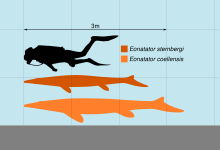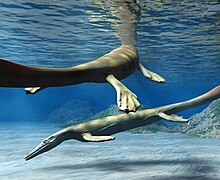| Eonatator | |
|---|---|

| |
| Holotype of E. sternbergii ( UPI R 163) [a] | |
|
Scientific classification
| |
| Domain: | Eukaryota |
| Kingdom: | Animalia |
| Phylum: | Chordata |
| Class: | Reptilia |
| Order: | Squamata |
| Clade: | † Mosasauria |
| Superfamily: | † Mosasauroidea |
| Family: | † Mosasauridae |
| Tribe: | † Halisaurini |
| Genus: | †
Eonatator Bardet et al. 2005 [1] |
| Type species | |
|
Clidastes sternbergii (
Wiman 1920)
| |
| Species | |
| Synonyms | |
| |
Eonatator is an extinct genus of marine lizard belonging to the mosasaur family. It is a close relative of Halisaurus, and part of the same subfamily, the Halisaurinae. It is known from the Late Cretaceous of North America, Colombia and Sweden. Originally, this taxon was included within Halisaurus, but was placed in its own genus, which also led to the subfamily Halisaurinae being created for the two genera. [1]
Discovery and naming
Eonatator is known from the Smoky Hill Chalk Member of the Niobrara Chalk Formation ( Late Coniacian to Early Campanian) of Kansas, [1] from the Eutaw Formation ( Santonian) and Mooreville Chalk Formation ( Selma Group; Santonian-Lower Campanian) of Alabama ( United States), [4] from the Kristianstad Basin of southern Sweden (late early Campanian), [5] and the unit Nivel de Lutitas y Arenas (Campanian) of the Olini Group in La Mesa, Colombia. [2]
The name Eonatator means "dawn swimmer" ( Greek eos = dawn + Latin natator = swimmer). Originally, it contained only a single species, E. sternbergii. [1] The species is named in honour of Charles H. Sternberg and his son, Levi, who discovered the type specimen in the Niobrara Chalk during the summer of 1918. [6] A second species, E. coellensis, was named for the town of Coello in the Department of Tolima in Colombia, near of which it was discovered. [2]
Description

Eonatator was a small mosasaur, with the type specimen of Eonatator sternbergii, UPI R 163, measuring approximately 2.6 metres (8.5 ft) long. [3] Bardet et al. (2005, p. 465 [1]) diagnose Eonatator sternbergii as follows: "Ambiguous characters: premaxilla- maxilla lateral suture ending posterior to 9th maxillary teeth; tail about 40% of the head and trunk length (convergent in mosasaurines); caudal vertebra length greater than width; fewer than four pygal vertebrae; femur length about twice distal width (convergent in Clidastes). Autapomorphies: parietal with smooth triangular table extending very far posteriorly, bearing medium-sized circular foramen, located at distance twice its diameter from the frontal-parietal suture, and surrounded anteriorly and posteriorly by two parallel ridges; rounded quadrate with regularly convex tympanic ala (wing); vertebral formula: seven cervicals, 24 dorsals, four pygals, 28 median caudals and at least 41 terminal caudals; humerus length approximately 2.5x distal width." E. coellensis is diagnosed by more retracted nostrils, between the 7 and the 17 maxillary teeth, premaxilla and maxilla with a short rostrum anterior to the first teeth; presence of a septomaxilla, a large prefrontal that makes most of the margin of the outer nostril, a short and wide frontal, a parietal foramen located near of the fronto-parietal suture, a triangular surface of the parietal with two medial depressions and 22 caudal vertebrae. [1]
The type specimen of E. coellensis, IGM p 881237, measures 2.8 metres (9.2 ft) long as preserved, but is missing part of its tail. This specimen had a 41.5 cm (16.3 in) long skull and lacked a complete tail. Still, it is remarkable for having remains of soft tissue in the ear region, the neck, thoracic and the abdominal region. Under the pygal vertebrae and the seventeenth dorsal vertebra there is a series of 20 small vertebrae centra and a flattened bone, that together measure 25 cm (9.8 in) in length. It have features of the mosasauroids, with three vertebrae with haemal arches and procoelic centra, that suggest the possibility that these small bones belong to an embryo of this species, although the lack of diagnostic fossils like the skull or teeth prevents a complete identification. In any case, it will be consequent with the ovoviviparism previously reported in mosasauroids like Carsosaurus. [2]
Classification

Like many mosasaurs, this genus has a complicated taxonomic history. The type specimen (UPI R 163, Uppsala University Palaeontological Institute, Uppsala, Sweden), a nearly complete skeleton, was originally referred to the genus Clidastes by Wiman and then to Halisaurus by Russell. Hence, Clidastes sternbergii became Halisaurus sternbergii. [7] Although some agreed with this generic attribution, other paleontologists suggested that while H. sternbergii did not belong to Clidastes, its designation under Halisaurus is questionable; Lingham-Soliar (1996) referred H. sternbergii to C. sternbergii again, but this has found no acceptance in other researchers. [3]
In 2005, Halisaurus sternbergii was reassigned to its own genus, Eonatator by Nathalie Bardet and colleagues along with the description of Halisaurus arambourgi and the creation of the subfamily Halisaurinae. [1] In the same year, Lindgren and Siverson suggested that Eonatator is an invalid junior synonym and should be classified as H. sternbergii, [8] but this has found no acceptance in other researchers who used the genus name Eonatator instead. [8] [2] [9]
Below is a cladogram following an analysis by Takuya Konishi and colleagues ( 2016) done during the description of Phosphorosaurus ponpetelegans, which showcases the internal relationships within the Halisaurinae. [9] The analysis excluded the dubious Halisaurus onchognathus and the genus Pluridens.
| Halisaurinae |
| |||||||||||||||||||||
In their 2023 description of the new Halisaurus species, H. hebae, Shaker et al. performed a phylogenetic analyses of members of the Halisaurinae. They suggested that Phosphorosaurus ponpetelegans and Eonatator coellensis were more closely related to the genus Halisaurus than the type species of their respective genera. They tentatively assigned both of these species to Halisaurus. The results of their analyses are displayed in the cladogram below: [10]
| Halisaurini |
| |||||||||||||||||||||||||||||||||||||||
Notes
- ^ Note that parts of the skull and tail's neural spines, among others, were restored with plaster to provide an erroneous Clidastes-like appearance. [3]
References
- ^ a b c d e f g Bardet, N.; Pereda Suberbiola, X.; Iarochene, M.; Baadi, B.; Amaghzaz, M. (2005). "A new species of Halisaurus from the Late Cretaceous phosphates of Morocco, and the phylogenetical relationships of the Halisaurinae (Squamata: Mosasauridae)". Zoological Journal of the Linnean Society. 143 (3): 447–472. doi: 10.1111/j.1096-3642.2005.00152.x.
- ^ a b c d e Páramo-Fonseca, María E. (2013). "Eonatator coellensis nov. sp. (Squamata: Mosasauridae), nueva especie del Cretácico Superior de Colombia" [Eonatator coellensis nov. sp. (Squamata: Mosasauridae), a new species from the Upper Cretaceous of Colombia] (PDF). Revista de la Academia Colombiana de Ciencias (in Spanish). 37 (145): 499–518. doi: 10.18257/raccefyn.31. ISSN 0370-3908. Archived from the original (PDF) on 2016-03-04. Retrieved 2014-06-28.
- ^ a b c Bardet, N.; Pereda-Suberbiola, X. (2001). "The basal mosasaurid Halisaurus sternbergii from the Late Cretaceous of Kansas (North America): a review of the Uppsala type specimen". Comptes Rendus de l'Académie des Sciences - Series IIA - Earth and Planetary Science. 332 (6): 395–402. doi: 10.1016/S1251-8050(00)01486-5.
- ^ Kejiri, T.; Ebersole, J.A.; Blewitt, H.L.; Ebersole, S.M. (2013). "An Overview of Late Cretaceous Vertebrates from Alabama". Bulletin of the Alabama Museum of Natural History. 31 (1): 46–71.
-
^ Källsten, L. (2015).
"Diversity and Ecology of a Middle Campanian (Late Cretaceous) Marine Reptile Assemblage from Skåne, Southern Sweden" (PDF). 28. Department of Earth Sciences, Uppsala University.
S2CID
201080155.
{{ cite journal}}: Cite journal requires|journal=( help) - ^ Sternberg, C. H. (1922). "Explorations of the Permian of Texas and the chalk of Kansas, 1918". Kansas Academy of Science, Transactions. 30 (1): 119–120.
- ^ Russell, Dale. A. (6 November 1967). "Systematics and Morphology of American Mosasaurs" (PDF). Bulletin of the Peabody Museum of Natural History (Yale University). Archived from the original (PDF) on 21 October 2022. Retrieved 20 January 2023.
- ^ a b Everhart, M.J. (2017). Oceans of Kansas, Second Edition: A Natural History of the Western Interior Sea (Life of the Past). Indiana University Press. p. 232. ISBN 978-0253026323.
- ^ a b Konishi, Takuya; Caldwell, Michael W.; Nishimura, Tomohiro; Sakurai, Kazuhiko; Tanoue, Kyo (2016-10-02). "A new halisaurine mosasaur (Squamata: Halisaurinae) from Japan: the first record in the western Pacific realm and the first documented insights into binocular vision in mosasaurs". Journal of Systematic Palaeontology. 14 (10): 809–839. doi: 10.1080/14772019.2015.1113447. ISSN 1477-2019.
- ^ Shaker, A. A.; Longrich, N. R.; Strougo, A.; Asan, A.; Bardet, N.; Mousa, M. K.; Tantawy, A. A.; Abu El-Kheir, G. A. (2023). "A new species of Halisaurus (Mosasauridae: Halisaurinae) from the lower Maastrichtian (Upper Cretaceous) of the Western Desert, Egypt". Cretaceous Research. 105719. doi: 10.1016/j.cretres.2023.105719.
Further reading
- Lindgren J, Siverson M. 2005. Halisaurus sternbergii, a small mosasaur with an intercontinental distribution. Journal of Paleontology 79 (4): 763–773.
External links
- Russellosaurins
- Santonian genus first appearances
- Campanian genus extinctions
- Mosasaurs of South America
- Late Cretaceous reptiles of South America
- Cretaceous Colombia
- Fossils of Colombia
- Mosasaurs of Europe
- Late Cretaceous reptiles of Europe
- Fossils of Sweden
- Fossil taxa described in 2005
- Taxa named by María Páramo



